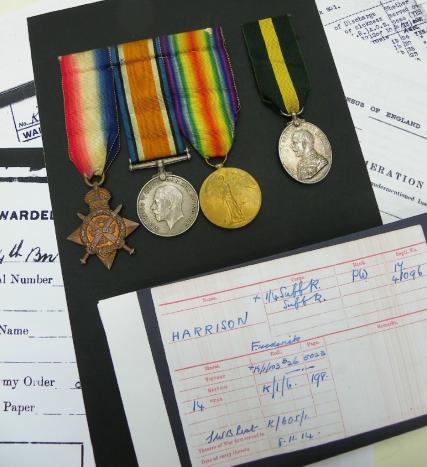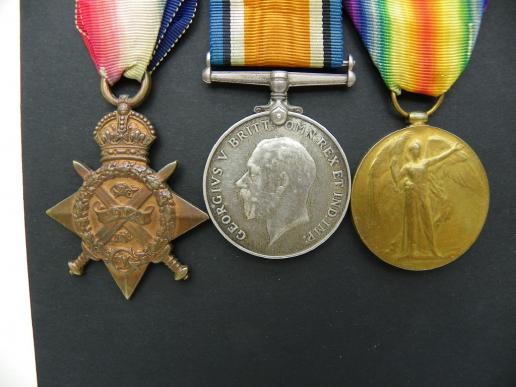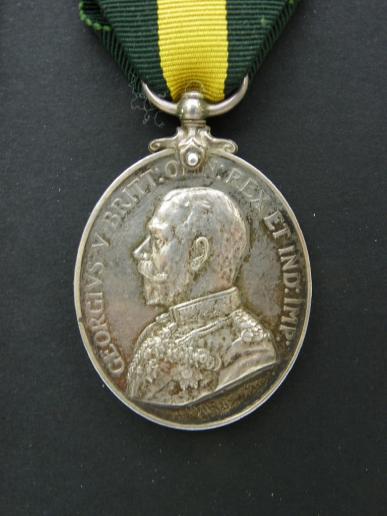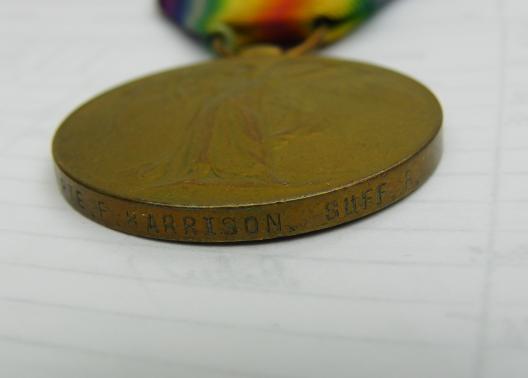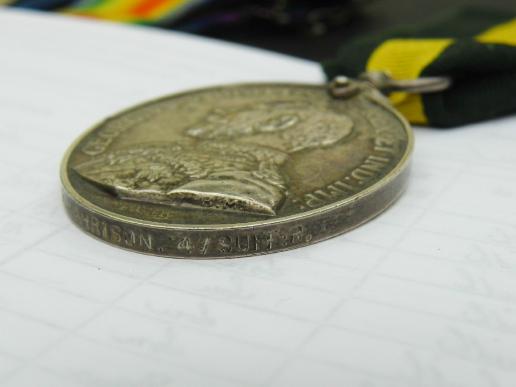Scarce 1914 Star Trio & TFEM Group to Suffolk Regiment.
A scarce and interesting group comprising of the 1914 star correctly named to 17 Private Frederick Harrison 1/4th Suffolk Regiment. The British war and Victory medal, correctly named to 17 Private Frederick Harrison, Suffolk Regiment and the territorial Force Efficiency medal, correctly named to 41096 Private Frederick Harrison. 4th Suffolk Regiment.
Frederick Harrison born in Ipswich in 1891, most of his younger life, he spent with his two brothers, Ernest and Edward and his sister Gertrude in St Johns Home for Boys and Girls, a home for pauper Children; the boys were taught to work on the land, and in tailoring and shoe-making. The girls were taught needlework and other household skills to equip them for domestic service, otherwise known as the ‘workhouse’, our Frederick chose to join the army when he came of age. He joined the 4th territorial battalion Suffolk regiment on the 2nd March 1908 and he was still serving when the Great War broke out, Frederick was called to duty and arrived in France on 8th November 1914, at first he was to undergo training for mobile warfare and a course of musketry; on the last day of November the battalion marched in the rain and wind over bad roads to Lambres and then on to Vieille Chapelle here joining the Jullunder brigade before moving on to the trenches at Bethune and La Beuvry. The battalion’s first real action was in the defence of Givenchy in the winter operations of 1914-1915. On the 10th March 1915 the 4th battalion took their place in the trenches at Neuve Chapelle; the attack began at noon the next day, the battalion fought hard, sometimes under fire from our own guns, but they drove the Germans from well-established positions in a trench by trench attack, but sadly it made little ground and the attack was deemed as failed, losing 217 men in the process, however Sergeant Sones was awarded the DCM for carrying messages for 48 consecutive hours under very heavy rifle and machine gun fire. Later sir John French congratulated the 4th battalion on their bearing at Neuve Chapelle.
The rest of spring 1915 was spent roughly in the same area supporting attacks on the enemy at Aubers ridge near Arras and Biez Farm and distillery at La Tourelle, here suffering over one hundred casualties; and on to Ypres where the battlefield was hell, there was hardly no respite from German shelling, the days must have seemed like months, but getting through the battle of St Julien with a total of fifty casualties, the battalion considered themselves very fortunate in deed.
After this, day to day life in the trench was mundane, carrying out trench duties, marching back and forth from billets in the village etc.
On June 21st the Germans bombarded the 4th battalions trenches with 5.9 Howitzers, an officer and three men were killed, and many anti – aircraft gun were put out of action. From here to the end of September the front line was pretty quiet, the 25th September saw the battalion involved with the main operations at Loos and in that battle Frederick was wounded by a gunshot wound to the neck and shoulder.
It is unclear how long he was hospitalised or if he returned to blighty for rest and recuperation, but he was not officially discharged until 20th August 1918, from the nature of his earlier wounds.
It always amazes me how any man could survive this war, the life of the soldier was a mixture of being bored to fighting for your life, at least Frederick survived, but what happened to him after, this is up to the new owner to find out. He was on the western front for two years and saw more than his fair share of the horrors, I’m sure, it is not known how severe his wounds were, did this have a major effect on his future life.
This group comes mounted on card for display and with copies of the 1891 and 1901census information, medal index card, medal roll card for the TFEM and the roll for the silver war badge.
The trio are mounted on a brooch bar as worn but the TFEM is separate, he was awarded the TFEM on 1st August 1918
All medals are in excellent original condition but they do have a few contact marks where they have been mounted together.
Code: 16980

